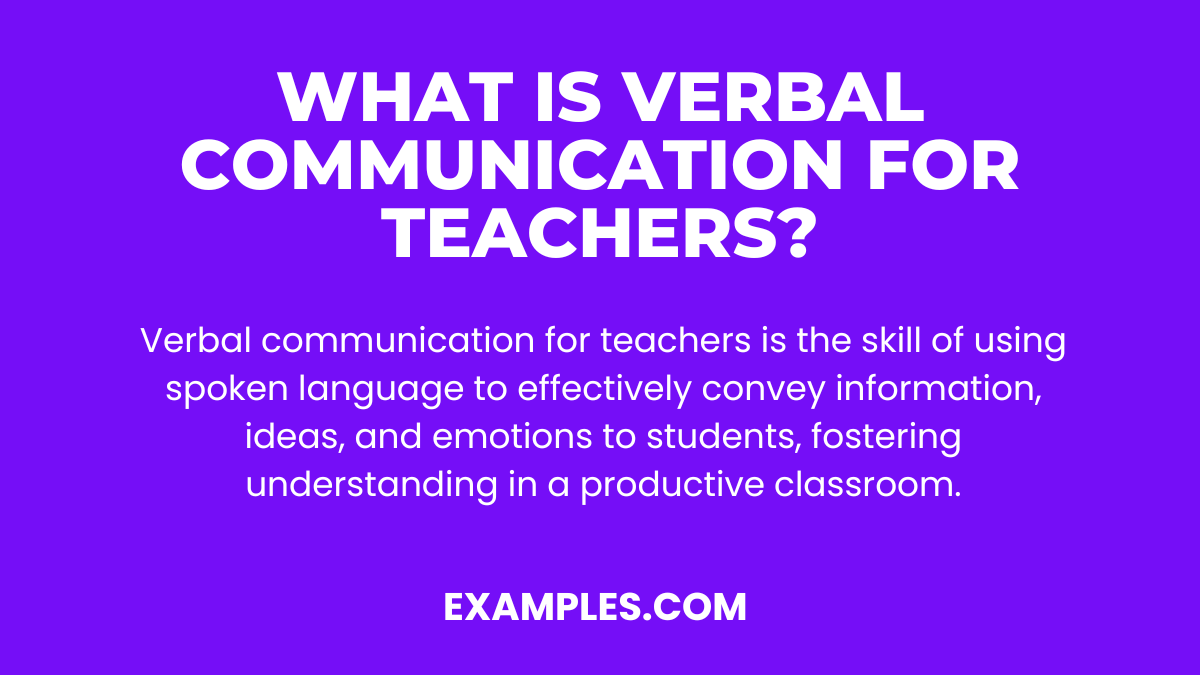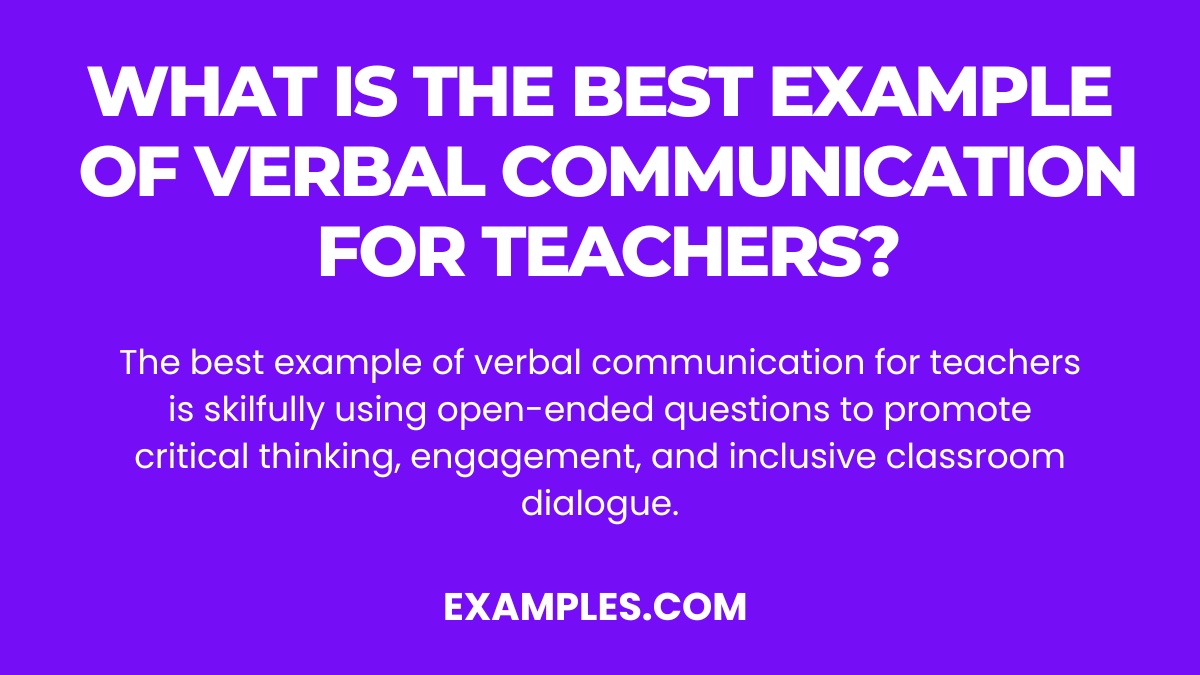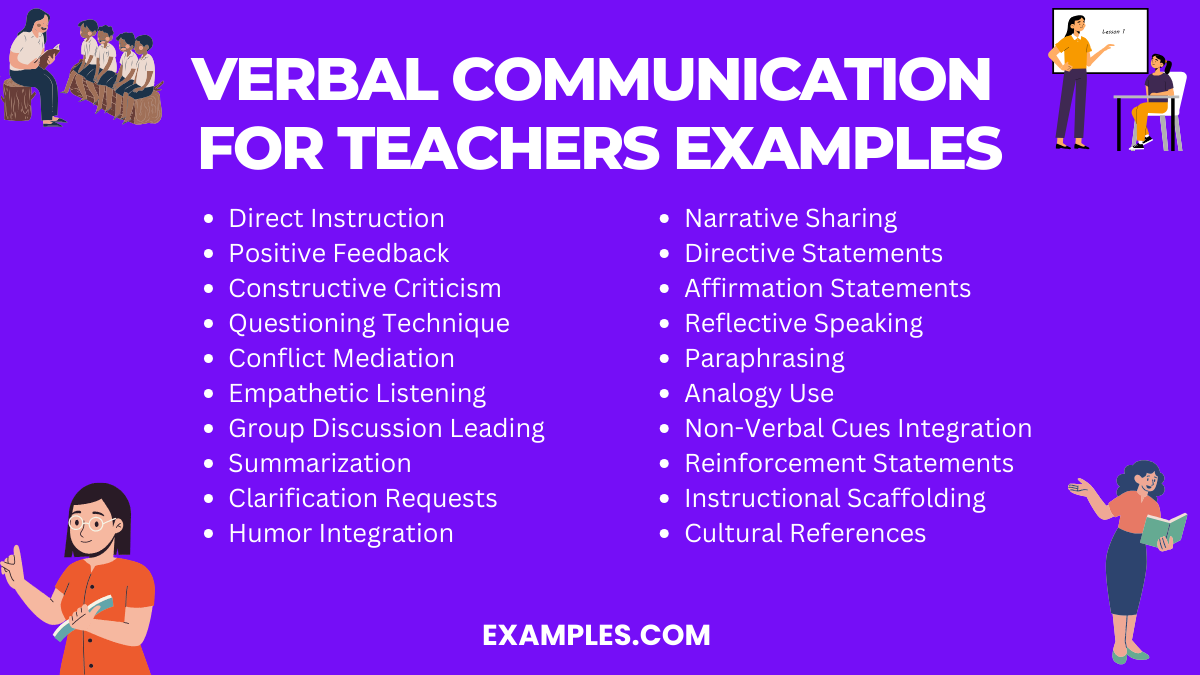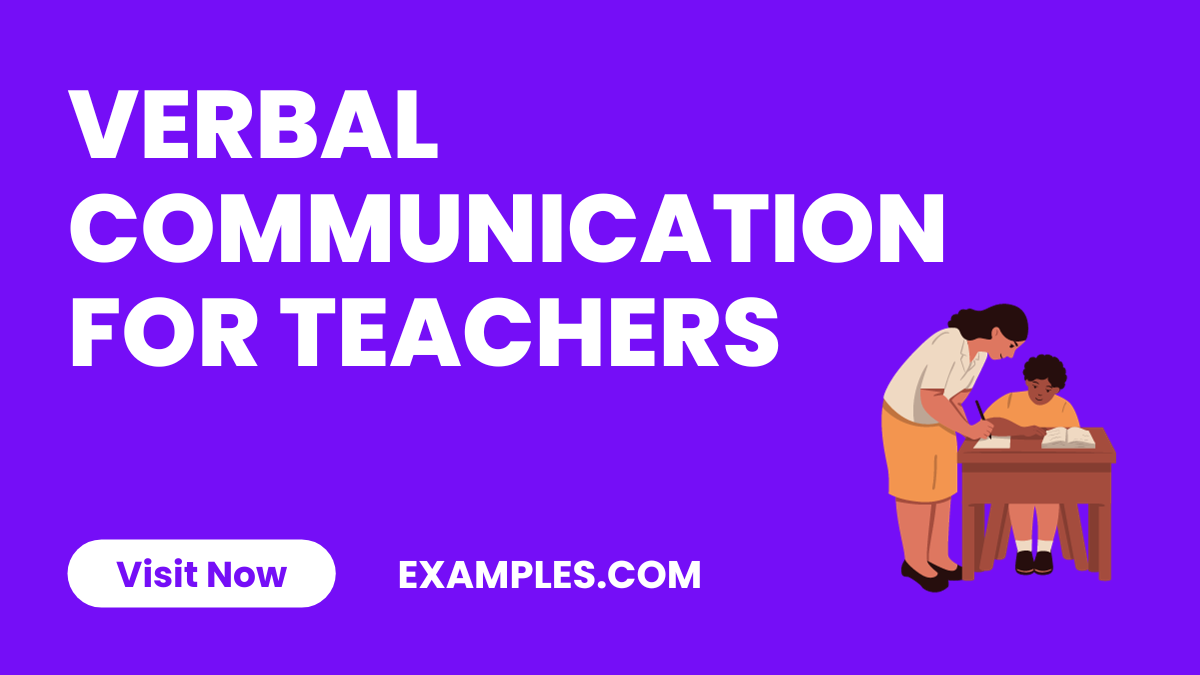19+ Verbal Communication for Teachers Examples
Explore the art of expression with our complete guide on Verbal Communication for Teachers. Delve into practical Communication Examples that bring clarity and engagement to the classroom. Understand the nuances of teacher-student dialogue, the power of words in education, and the strategies that make communication effective and impactful. This resource is tailored for educators seeking to enhance their verbal skills and create dynamic learning environments.
Download Communication Skills for Teachers PDF
What is Verbal Communication for Teachers? – Meaning

Verbal communication for teachers refers to the way educators use spoken language to convey information, ideas, and emotions to their students. It’s a critical skill that involves delivering lessons, providing feedback, asking questions, and engaging in two-way dialogues. Effective verbal communication is more than just speaking; it’s about ensuring clarity, fostering understanding, and adapting one’s language to suit the educational needs of various student groups. It is the foundation of a productive and positive classroom environment.
What is the Best Example of Verbal Communication for Teachers?

The best example of verbal communication for teachers might be the strategic use of open-ended questions. This technique encourages students to think critically and express their thoughts, promoting a more interactive and student-centered learning environment. By asking questions that require more than a yes or no answer, teachers stimulate deeper learning, facilitate discussion, and understand students’ comprehension levels. This approach exemplifies effective communication as it fosters engagement, checks for understanding, and supports a constructive and inclusive classroom dialogue.
20 Verbal Communication for Teachers Examples

Discover the essence of classroom dialogue with 20 transformative Verbal Communication Examples. Unveil the secrets of What Percent of Communication is Verbal? and refine your approach with adept Verbal Communication Techniques. Understand the Advantages and Disadvantages of Verbal Communication to balance and enhance interactions. Explore the diverse Functions of Verbal Communication, the Types of Verbal Communication prevalent in education, and the core Verbal Communication Skills every educator should master. Finally, embrace Ways to Improve Verbal Communication Skills for a more effective and inspiring teaching journey.
- Direct Instruction: Clearly explaining concepts.
Cause: Need for clarity. Fix: Use simple language and examples. - Positive Feedback: Encouraging students.
Cause: Boost morale. Fix: Offer specific praises regularly. - Constructive Criticism: Guiding improvements.
Cause: Misunderstandings or errors. Fix: Pair critiques with guidance. - Questioning Technique: Stimulating critical thinking.
Cause: Engage students. Fix: Use open and closed questions appropriately. - Conflict Mediation: Addressing disputes.
Cause: Miscommunications or disagreements. Fix: Active listening and neutral language. - Empathetic Listening: Understanding student perspectives.
Cause: Emotional barriers to learning. Fix: Show genuine concern and validation. - Group Discussion Leading: Facilitating student interactions.
Cause: Enhance collaborative learning. Fix: Set clear objectives and roles. - Summarization: Recapping main points.
Cause: Reinforce learning. Fix: Highlight key ideas and encourage note-taking. - Clarification Requests: Ensuring understanding.
Cause: Prevent misconceptions. Fix: Invite questions and confirm comprehension. - Humor Integration: Lightening the atmosphere.
Cause: Reduce stress. Fix: Share appropriate and relevant jokes. - Narrative Sharing: Relating content with stories.
Cause: Increase engagement. Fix: Use relatable and educational anecdotes. - Directive Statements: Providing clear instructions.
Cause: Guide student actions. Fix: Use concise and specific directions. - Affirmation Statements: Validating student efforts.
Cause: Encourage persistence. Fix: Recognize and appreciate efforts openly. - Reflective Speaking: Demonstrating thought consideration.
Cause: Model reflective learning. Fix: Share personal thought processes. - Paraphrasing: Restating student responses.
Cause: Ensure understanding. Fix: Reflect and build on student contributions. - Analogy Use: Connecting new to known.
Cause: Facilitate comprehension. Fix: Use relevant and familiar comparisons. - Non-Verbal Cues Integration: Complementing words with gestures.
Cause: Enhance meaning. Fix: Use appropriate body language. - Reinforcement Statements: Strengthening desired behaviors.
Cause: Encourage repetition. Fix: Provide immediate and positive feedback. - Instructional Scaffolding: Building on prior knowledge.
Cause: Support learning progression. Fix: Gradually increase complexity. - Cultural References: Making content relatable.
Cause: Diverse classrooms. Fix: Include varied and inclusive examples.
Verbal Communication for Teachers at School
Unlock the potential of classroom dialogue with insights into Verbal Communication for School. Engage students effectively, using tailored strategies that reflect the dynamic Verbal Communication in the Workplace, ensuring a robust educational environment. Harness Verbal Communication for Students to foster understanding and respect, employing techniques that resonate with youthful minds and diverse classroom settings, including those adapted for Verbal Communication for Autism.
- Daily Check-Ins: Start each day with a personalized greeting. “Good morning, [Student’s Name]! How are you today?”
- Instructional Clarity: Break down complex tasks into understandable steps. “First, read the chapter, then answer the questions at the end.”
- Encouraging Participation: Motivate students to share ideas. “I’d love to hear your thoughts on this topic.”
- Peer Interaction Promotion: Foster a cooperative learning environment. “Turn to your partner and discuss your solution.”
- Cultural Sensitivity: Address students in ways that respect their backgrounds. “Let’s see how this topic relates to different cultures.”
Verbal Communication for Teachers at Interview
Master your next educational career move with a deep understanding of Verbal Communication for Teachers at Interview. Showcase your ability to articulate teaching philosophies, classroom management strategies, and student engagement techniques, drawing from the rich tapestry of Verbal Communication in Business and Verbal Communication in Healthcare where clear, concise, and compassionate communication is key. Present yourself as a candidate who understands and values the power of words in shaping futures.
- Teaching Philosophy Articulation: Clearly express your educational values. “I believe in fostering a growth mindset in every student.”
- Classroom Management Strategies: Discuss your approach to maintaining order. “I manage classrooms by setting clear expectations and consistent consequences.”
- Experience Sharing: Detail past successes and learnings. “At my previous school, I initiated a reading program that…”
- Student-Centered Approach: Convey your focus on student needs. “My teaching adapts to each student’s unique learning style.”
- Response to Scenarios: Provide solutions to hypothetical situations. “If faced with a disruptive class, I would first…”
What is the Importance of Effective Verbal Communication in the Teaching Profession?
Effective verbal communication is pivotal in teaching, shaping how educators convey information, engage students, and foster a positive learning environment. Understanding Why you need Verbal Communication Skills is fundamental for educators to inspire, instruct, and impact student learning effectively. It’s about more than transferring knowledge; it’s about building relationships, encouraging exploration, and facilitating understanding.
- Enhances Understanding: Clear communication ensures that students grasp the lessons, reducing confusion and promoting better academic outcomes.
- Builds Relationships: Positive verbal interactions help build trust and rapport between teachers and students, creating a safe learning atmosphere.
- Facilitates Feedback: Constructive communication allows teachers to provide feedback that motivates and guides students towards improvement.
- Encourages Participation: Effective questioning and discussion techniques invite student engagement and active learning.
- Resolves Conflicts: Skillful verbal communication helps address and resolve misunderstandings and conflicts, maintaining a harmonious classroom environment.
How can Teachers Adapt their Verbal Communication to different Age Groups or Grade Levels?
Adapting verbal communication to suit various age groups or grade levels is essential for maximizing learning outcomes. Recognizing How to Improve Verbal Communication Skills and the Importance of Verbal Communication allows teachers to modify their language, tone, and delivery to meet the developmental and cognitive needs of their students effectively.
- Simplify Language for Younger Students: Use age-appropriate vocabulary and shorter sentences to ensure understanding among younger learners.
- Incorporate Relevant Examples: Tailor examples and stories to match the interests and experiences of the specific age group.
- Adjust Tone and Pace: Younger children might benefit from a more animated tone and slower pace, while older students may prefer a more direct and faster delivery.
- Encourage Age-Appropriate Interaction: Facilitate discussions and activities that are suitable for the students’ social and cognitive levels.
- Use Technology and Media: Especially with older students, integrate modern communication methods and digital tools to enhance engagement and relevance.
What are the Verbal Communication Strategies used in Teaching?
Teaching skills are the foundation of effective education, and in today’s dynamic classrooms, having the right Tools for Teachers is essential. These skills encompass a wide range of abilities, from lesson planning and classroom management to fostering student engagement and delivering content with clarity. Moreover, the modern teaching landscape has been significantly enhanced by various tools for teachers, including educational technology, digital resources, and innovative teaching methods. These tools empower educators to adapt to diverse learning styles and cater to individual student needs, ultimately enriching the teaching and learning experience. Thus, a combination of Teaching Skills and the right tools equips educators to excel in their mission of shaping the future generation.
How can a Teacher Improve Verbal Communication?
To improve verbal communication, a teacher can practice active listening, continuously expand their vocabulary, and receive feedback. Understanding Rules of Verbal Communication ensures clarity and effectiveness.
How Important are the Verbal Forms of Communication to the Teachers?
Verbal forms of communication are vital for teachers to deliver lessons, manage classrooms, and connect with students. Balancing Verbal vs Written Communication and Verbal vs Oral Communication is essential for effective teaching.
What is the Verbal Communication Technique used in Teaching?
Verbal communication in teaching involves clear articulation, active listening, and engaging dialogue between teachers and students to convey information, foster understanding, and promote learning.
In conclusion, effective verbal communication for teachers is paramount. Examples showcase its impact on student engagement and comprehension. Signs of poor communication include disinterest and confusion. To improve, teachers should actively listen, use clear language, and adapt to student needs. By prioritizing effective verbal communication, educators can create a positive and enriching learning environment.
19+ Verbal Communication for Teachers Examples

Explore the art of expression with our complete guide on Verbal Communication for Teachers. Delve into practical Communication Examples that bring clarity and engagement to the classroom. Understand the nuances of teacher-student dialogue, the power of words in education, and the strategies that make communication effective and impactful. This resource is tailored for educators seeking to enhance their verbal skills and create dynamic learning environments.
Download Communication Skills for Teachers PDF
What is Verbal Communication for Teachers? – Meaning

Verbal communication for teachers refers to the way educators use spoken language to convey information, ideas, and emotions to their students. It’s a critical skill that involves delivering lessons, providing feedback, asking questions, and engaging in two-way dialogues. Effective verbal communication is more than just speaking; it’s about ensuring clarity, fostering understanding, and adapting one’s language to suit the educational needs of various student groups. It is the foundation of a productive and positive classroom environment.
What is the Best Example of Verbal Communication for Teachers?

The best example of verbal communication for teachers might be the strategic use of open-ended questions. This technique encourages students to think critically and express their thoughts, promoting a more interactive and student-centered learning environment. By asking questions that require more than a yes or no answer, teachers stimulate deeper learning, facilitate discussion, and understand students’ comprehension levels. This approach exemplifies effective communication as it fosters engagement, checks for understanding, and supports a constructive and inclusive classroom dialogue.
20 Verbal Communication for Teachers Examples

Discover the essence of classroom dialogue with 20 transformative Verbal Communication Examples. Unveil the secrets of What Percent of Communication is Verbal? and refine your approach with adept Verbal Communication Techniques. Understand the Advantages and Disadvantages of Verbal Communication to balance and enhance interactions. Explore the diverse Functions of Verbal Communication, the Types of Verbal Communication prevalent in education, and the core Verbal Communication Skills every educator should master. Finally, embrace Ways to Improve Verbal Communication Skills for a more effective and inspiring teaching journey.
Direct Instruction: Clearly explaining concepts.
Cause: Need for clarity. Fix: Use simple language and examples.Positive Feedback: Encouraging students.
Cause: Boost morale. Fix: Offer specific praises regularly.Constructive Criticism: Guiding improvements.
Cause: Misunderstandings or errors. Fix: Pair critiques with guidance.Questioning Technique: Stimulating critical thinking.
Cause: Engage students. Fix: Use open and closed questions appropriately.Conflict Mediation: Addressing disputes.
Cause: Miscommunications or disagreements. Fix: Active listening and neutral language.Empathetic Listening: Understanding student perspectives.
Cause: Emotional barriers to learning. Fix: Show genuine concern and validation.Group Discussion Leading: Facilitating student interactions.
Cause: Enhance collaborative learning. Fix: Set clear objectives and roles.Summarization: Recapping main points.
Cause: Reinforce learning. Fix: Highlight key ideas and encourage note-taking.Clarification Requests: Ensuring understanding.
Cause: Prevent misconceptions. Fix: Invite questions and confirm comprehension.Humor Integration: Lightening the atmosphere.
Cause: Reduce stress. Fix: Share appropriate and relevant jokes.Narrative Sharing: Relating content with stories.
Cause: Increase engagement. Fix: Use relatable and educational anecdotes.Directive Statements: Providing clear instructions.
Cause: Guide student actions. Fix: Use concise and specific directions.Affirmation Statements: Validating student efforts.
Cause: Encourage persistence. Fix: Recognize and appreciate efforts openly.Reflective Speaking: Demonstrating thought consideration.
Cause: Model reflective learning. Fix: Share personal thought processes.Paraphrasing: Restating student responses.
Cause: Ensure understanding. Fix: Reflect and build on student contributions.Analogy Use: Connecting new to known.
Cause: Facilitate comprehension. Fix: Use relevant and familiar comparisons.Non-Verbal Cues Integration: Complementing words with gestures.
Cause: Enhance meaning. Fix: Use appropriate body language.Reinforcement Statements: Strengthening desired behaviors.
Cause: Encourage repetition. Fix: Provide immediate and positive feedback.Instructional Scaffolding: Building on prior knowledge.
Cause: Support learning progression. Fix: Gradually increase complexity.Cultural References: Making content relatable.
Cause: Diverse classrooms. Fix: Include varied and inclusive examples.
Verbal Communication for Teachers at School
Unlock the potential of classroom dialogue with insights into Verbal Communication for School. Engage students effectively, using tailored strategies that reflect the dynamic Verbal Communication in the Workplace, ensuring a robust educational environment. Harness Verbal Communication for Students to foster understanding and respect, employing techniques that resonate with youthful minds and diverse classroom settings, including those adapted for Verbal Communication for Autism.
Daily Check-Ins: Start each day with a personalized greeting. “Good morning, [Student’s Name]! How are you today?”
Instructional Clarity: Break down complex tasks into understandable steps. “First, read the chapter, then answer the questions at the end.”
Encouraging Participation: Motivate students to share ideas. “I’d love to hear your thoughts on this topic.”
Peer Interaction Promotion: Foster a cooperative learning environment. “Turn to your partner and discuss your solution.”
Cultural Sensitivity: Address students in ways that respect their backgrounds. “Let’s see how this topic relates to different cultures.”
Verbal Communication for Teachers at Interview
Master your next educational career move with a deep understanding of Verbal Communication for Teachers at Interview. Showcase your ability to articulate teaching philosophies, classroom management strategies, and student engagement techniques, drawing from the rich tapestry of Verbal Communication in Business and Verbal Communication in Healthcare where clear, concise, and compassionate communication is key. Present yourself as a candidate who understands and values the power of words in shaping futures.
Teaching Philosophy Articulation: Clearly express your educational values. “I believe in fostering a growth mindset in every student.”
Classroom Management Strategies: Discuss your approach to maintaining order. “I manage classrooms by setting clear expectations and consistent consequences.”
Experience Sharing: Detail past successes and learnings. “At my previous school, I initiated a reading program that…”
Student-Centered Approach: Convey your focus on student needs. “My teaching adapts to each student’s unique learning style.”
Response to Scenarios: Provide solutions to hypothetical situations. “If faced with a disruptive class, I would first…”
What is the Importance of Effective Verbal Communication in the Teaching Profession?
Effective verbal communication is pivotal in teaching, shaping how educators convey information, engage students, and foster a positive learning environment. Understanding Why you need Verbal Communication Skills is fundamental for educators to inspire, instruct, and impact student learning effectively. It’s about more than transferring knowledge; it’s about building relationships, encouraging exploration, and facilitating understanding.
Enhances Understanding: Clear communication ensures that students grasp the lessons, reducing confusion and promoting better academic outcomes.
Builds Relationships: Positive verbal interactions help build trust and rapport between teachers and students, creating a safe learning atmosphere.
Facilitates Feedback: Constructive communication allows teachers to provide feedback that motivates and guides students towards improvement.
Encourages Participation: Effective questioning and discussion techniques invite student engagement and active learning.
Resolves Conflicts: Skillful verbal communication helps address and resolve misunderstandings and conflicts, maintaining a harmonious classroom environment.
How can Teachers Adapt their Verbal Communication to different Age Groups or Grade Levels?
Adapting verbal communication to suit various age groups or grade levels is essential for maximizing learning outcomes. Recognizing How to Improve Verbal Communication Skills and the Importance of Verbal Communication allows teachers to modify their language, tone, and delivery to meet the developmental and cognitive needs of their students effectively.
Simplify Language for Younger Students: Use age-appropriate vocabulary and shorter sentences to ensure understanding among younger learners.
Incorporate Relevant Examples: Tailor examples and stories to match the interests and experiences of the specific age group.
Adjust Tone and Pace: Younger children might benefit from a more animated tone and slower pace, while older students may prefer a more direct and faster delivery.
Encourage Age-Appropriate Interaction: Facilitate discussions and activities that are suitable for the students’ social and cognitive levels.
Use Technology and Media: Especially with older students, integrate modern communication methods and digital tools to enhance engagement and relevance.
What are the Verbal Communication Strategies used in Teaching?
Teaching skills are the foundation of effective education, and in today’s dynamic classrooms, having the right Tools for Teachers is essential. These skills encompass a wide range of abilities, from lesson planning and classroom management to fostering student engagement and delivering content with clarity. Moreover, the modern teaching landscape has been significantly enhanced by various tools for teachers, including educational technology, digital resources, and innovative teaching methods. These tools empower educators to adapt to diverse learning styles and cater to individual student needs, ultimately enriching the teaching and learning experience. Thus, a combination of Teaching Skills and the right tools equips educators to excel in their mission of shaping the future generation.
How can a Teacher Improve Verbal Communication?
To improve verbal communication, a teacher can practice active listening, continuously expand their vocabulary, and receive feedback. Understanding Rules of Verbal Communication ensures clarity and effectiveness.
How Important are the Verbal Forms of Communication to the Teachers?
Verbal forms of communication are vital for teachers to deliver lessons, manage classrooms, and connect with students. Balancing Verbal vs Written Communication and Verbal vs Oral Communication is essential for effective teaching.
What is the Verbal Communication Technique used in Teaching?
Verbal communication in teaching involves clear articulation, active listening, and engaging dialogue between teachers and students to convey information, foster understanding, and promote learning.
In conclusion, effective verbal communication for teachers is paramount. Examples showcase its impact on student engagement and comprehension. Signs of poor communication include disinterest and confusion. To improve, teachers should actively listen, use clear language, and adapt to student needs. By prioritizing effective verbal communication, educators can create a positive and enriching learning environment.


